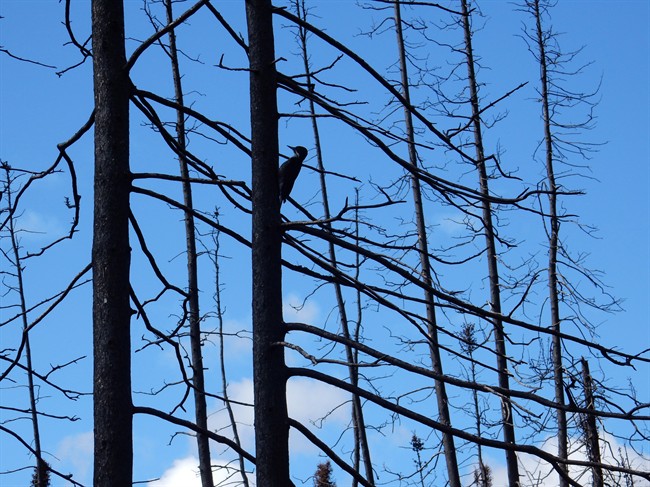The drumming of black-backed woodpeckers is a sure sign the boreal forest is slowly bouncing back from the devastation caused by last spring’s wildfire near Fort McMurray.

Woodpeckers are busy in the roughly 5,900-square-kilometre area in northern Alberta that was torched. The birds gorge on bugs that have been attracted to dead and dying trees.
Flames that killed birds and animals or forced them to flee have created conditions for different species to flourish.
“The population of those kinds of woodpeckers will just sort of explode in that early post-fire habitat,” said Steve Van Wilgenburg, a boreal ecologist with the Canadian Wildlife Service.
“There are suddenly all these open territories that they can move into.”
READ MORE: Fort McMurray wildfire likely killed all wildlife in its path: expert
There are other signs of regeneration across the fire-scarred region. Lush, green shoots from aspens, the predominant tree species in the area, have burst from the burned soil and are a metre high in some areas. The root systems of aspens can survive the flames and heat from wildfires.
Dan Thompson, a research scientist with the Canadian Forest Service, said a warm, wet summer created ideal conditions for regrowth.
READ MORE: Massive $1.3M tree-planting effort in Fort McMurray to start this spring
Within about 10 years, aspens will be tall enough to appear like a forest again and will grow to pre-fire levels in about 30 years.
Other tree species such as spruce will take much longer to recover.
Dramatic pictures last May of walls of flames consuming stands of trees might leave the impression that nothing could withstand such a destructive fire.
But wildfires have been part of the life cycle of the western boreal forest for thousands of years, Thompson said.
“The ecosystem there is really adaptive to fire,” he said. “Even though we had really bad human consequences, the natural consequences of this fire are just a tiny, tiny fraction of what the human consequences were.”
Watch below: During an update on the Fort McMurray wildfire in May 2016, Bernie Schmitte, forestry manager in Fort McMurray, explained how a Boreal forest is a fire-dependant ecosystem that adapts itself to being easily ignitable.

The wildfire killed or displaced an unknown number of animals and its aftermath poses different problems for different species.
Deer, bears, wolves and caribou would have tried to move out of the flames’ path. Smaller critters such as mice and voles would have sought shelter in burrows deep in the ground.
The challenge for animals will be to find enough food and cover for them to survive. Van Wilgenburg said some animals might have been able to find refuge in areas within the fire zone that didn’t burn.
READ MORE: ‘Hope tree’ a gift to Fort McMurray from a 6- year-old Edmonton girl
The destruction of older trees that provide lichen for caribou or homes for martens and fishers could mean their populations won’t recover until the end of the century.
Despite the damage, within a dozen years most people will hardly notice signs of the extensive wildfire, Van Wilgenburg said.
Dead trees that look like burnt matchsticks will fall and new trees will take their place.
“It is remarkable how quickly you can no longer easily tell that a forest fire was through an area.”
Watch below: A picture of a small sapling planted in the burned forest near Fort McMurray went viral following last May’s wildfire. It was planted by Darren Anderson, a firefighter from Strathcona County. His six-year-old daughter gave him the tree as a gift for the residents of Fort McMurray.



Comments